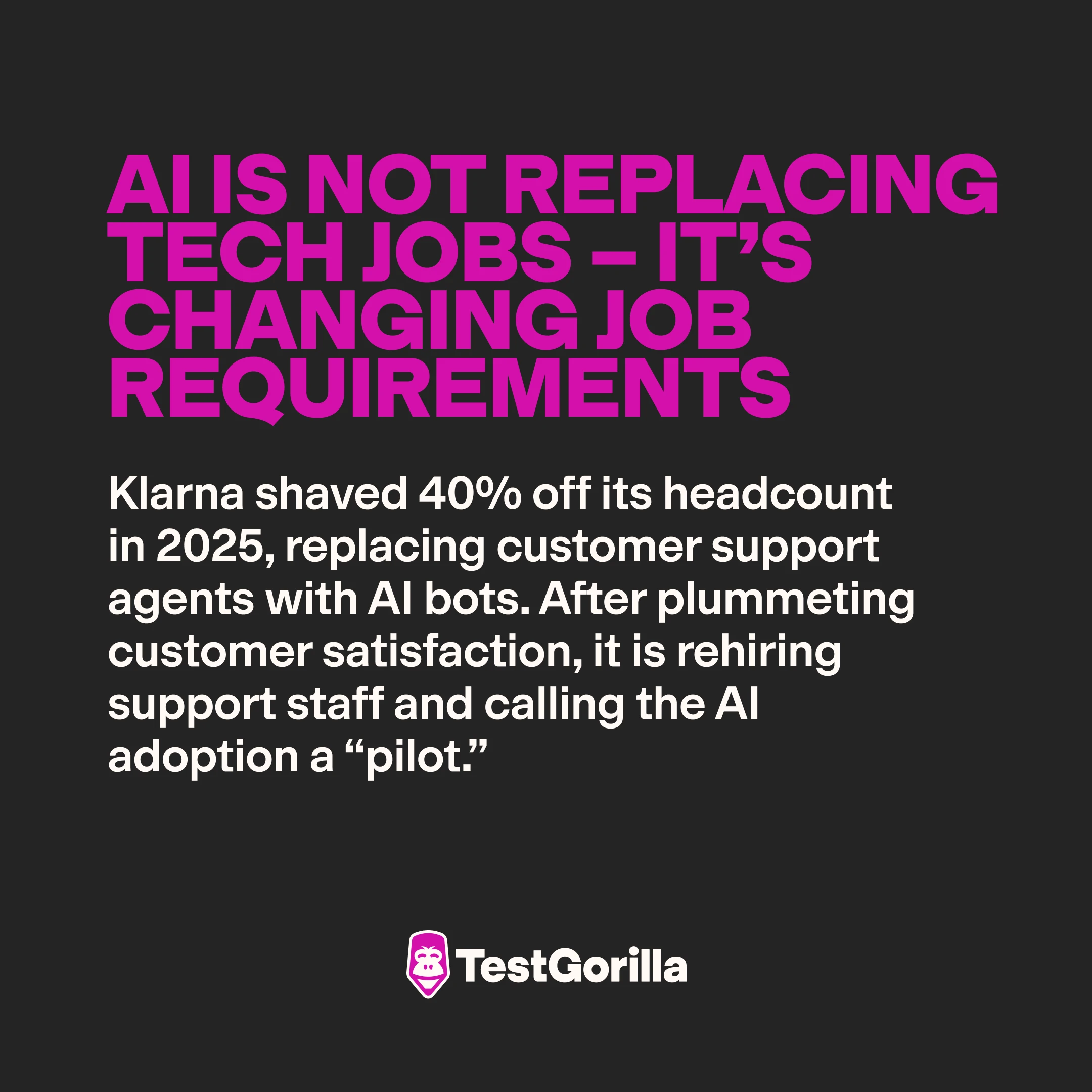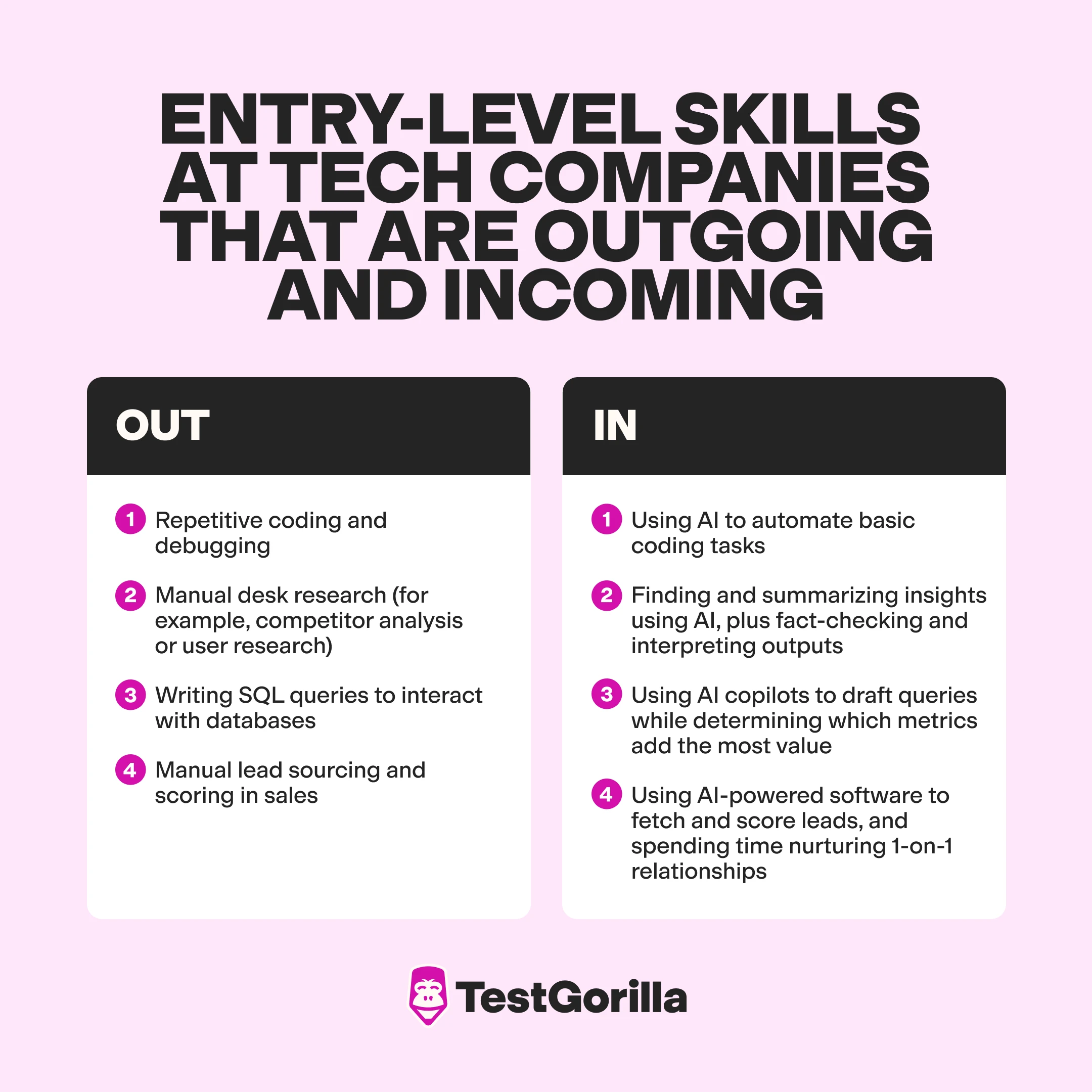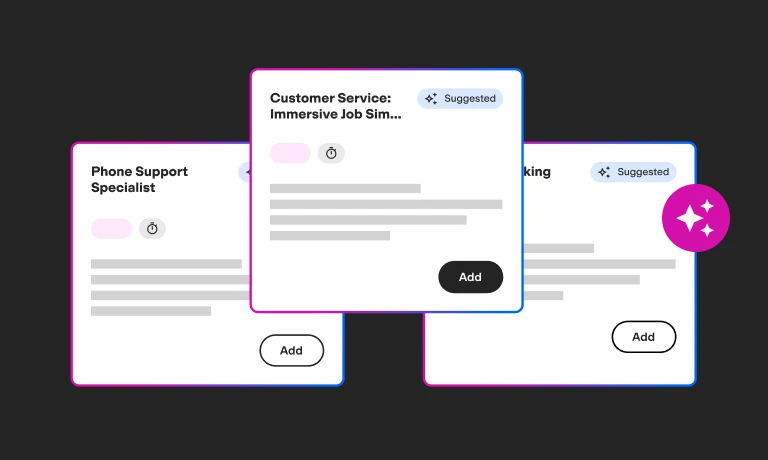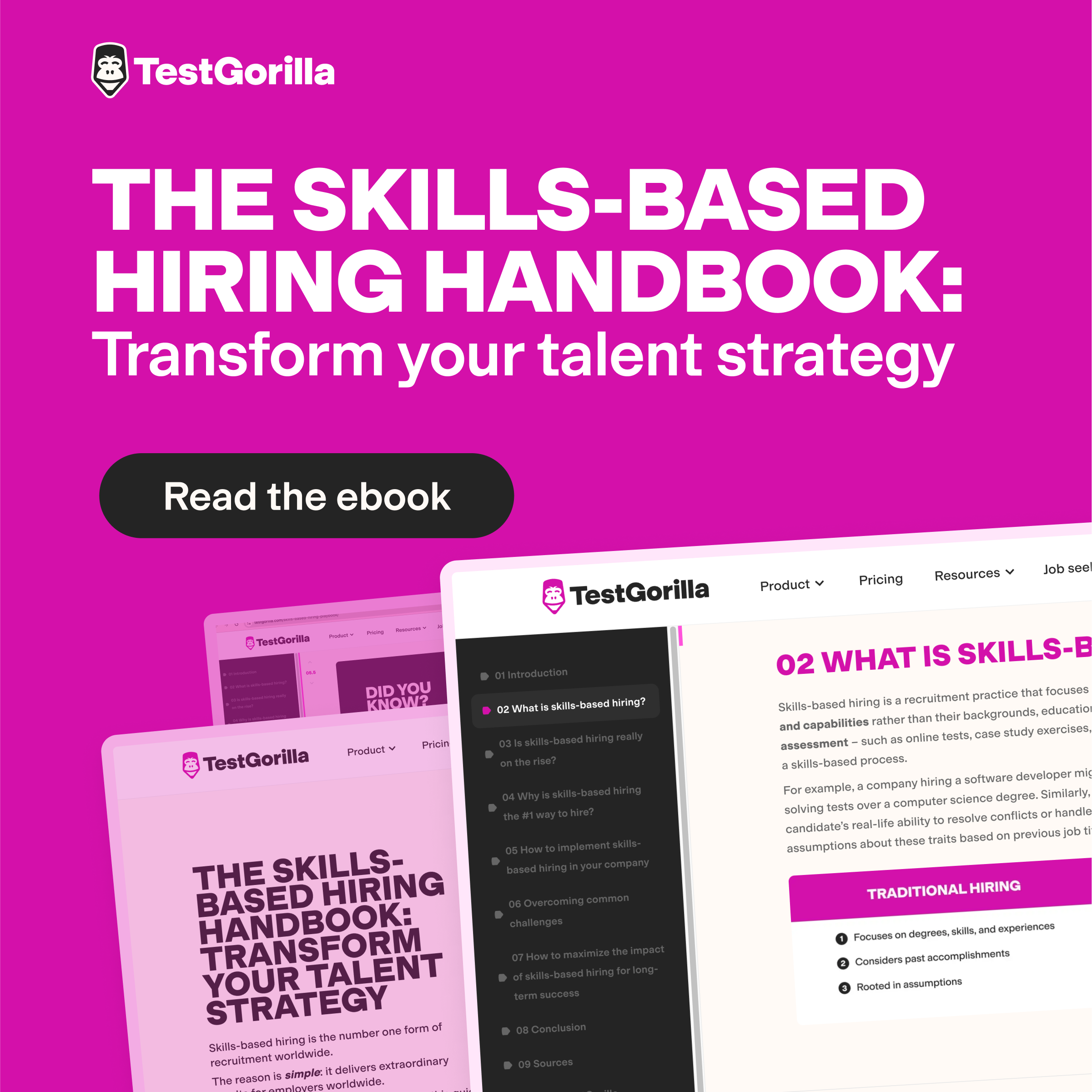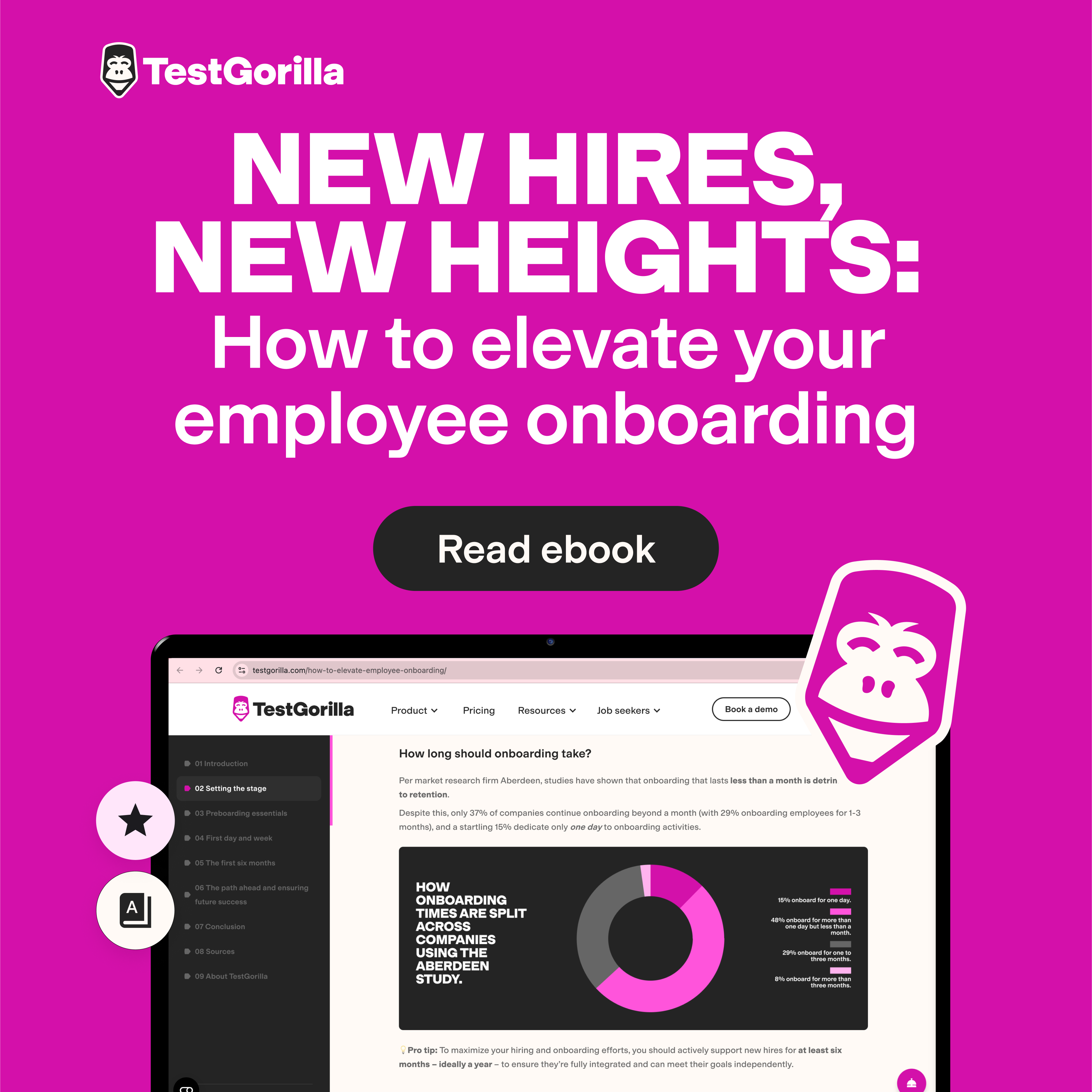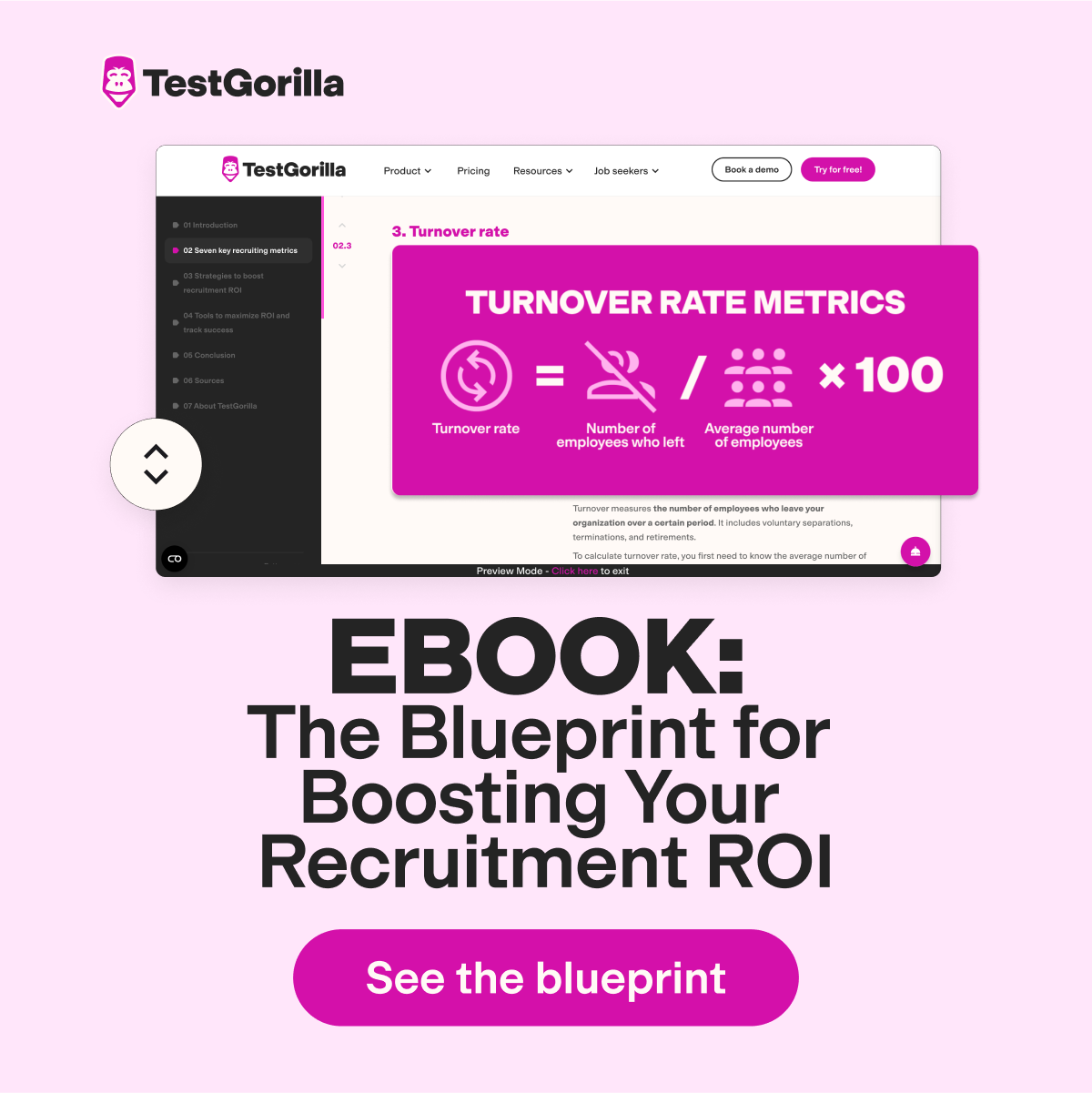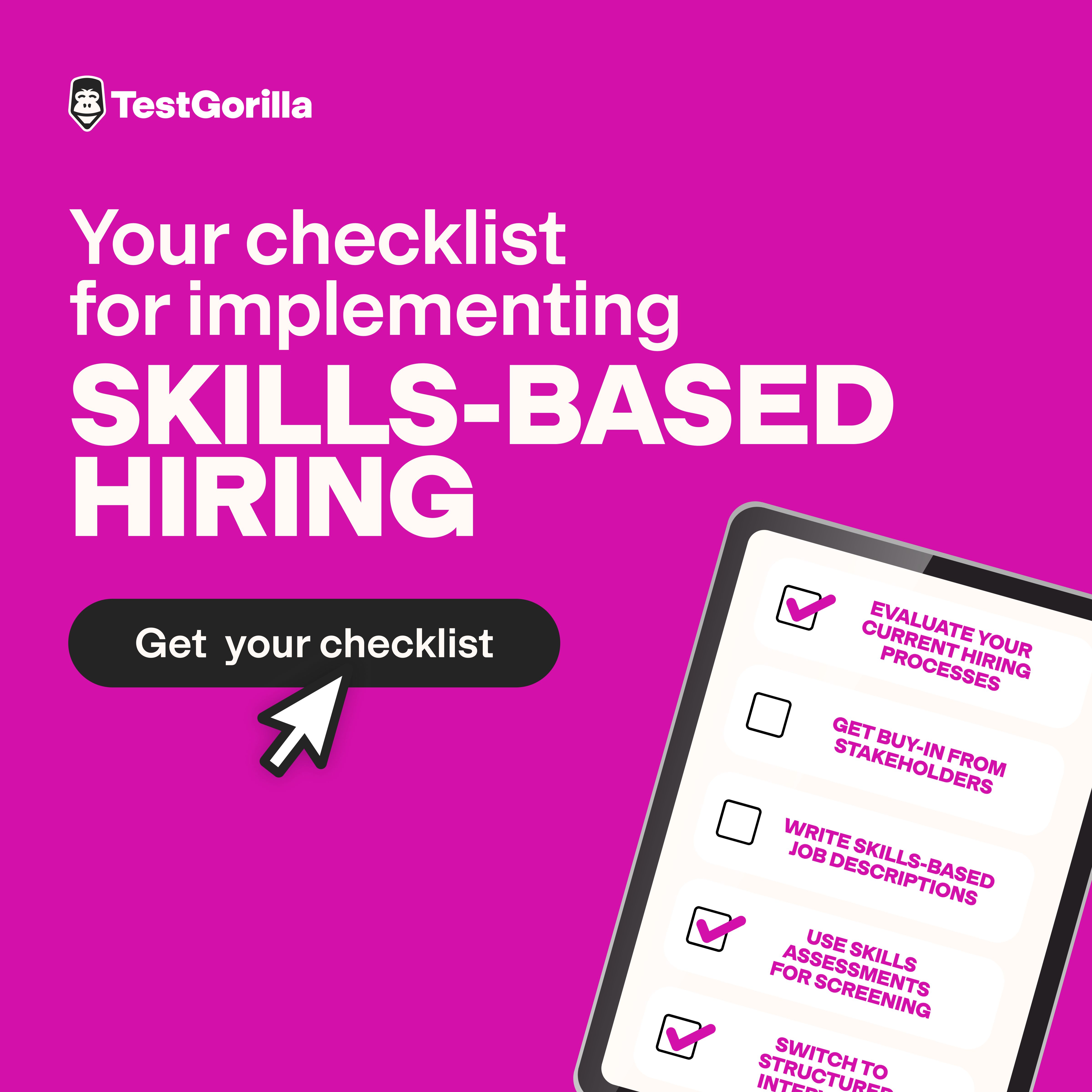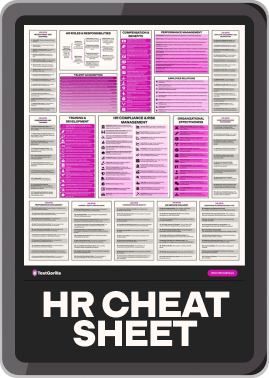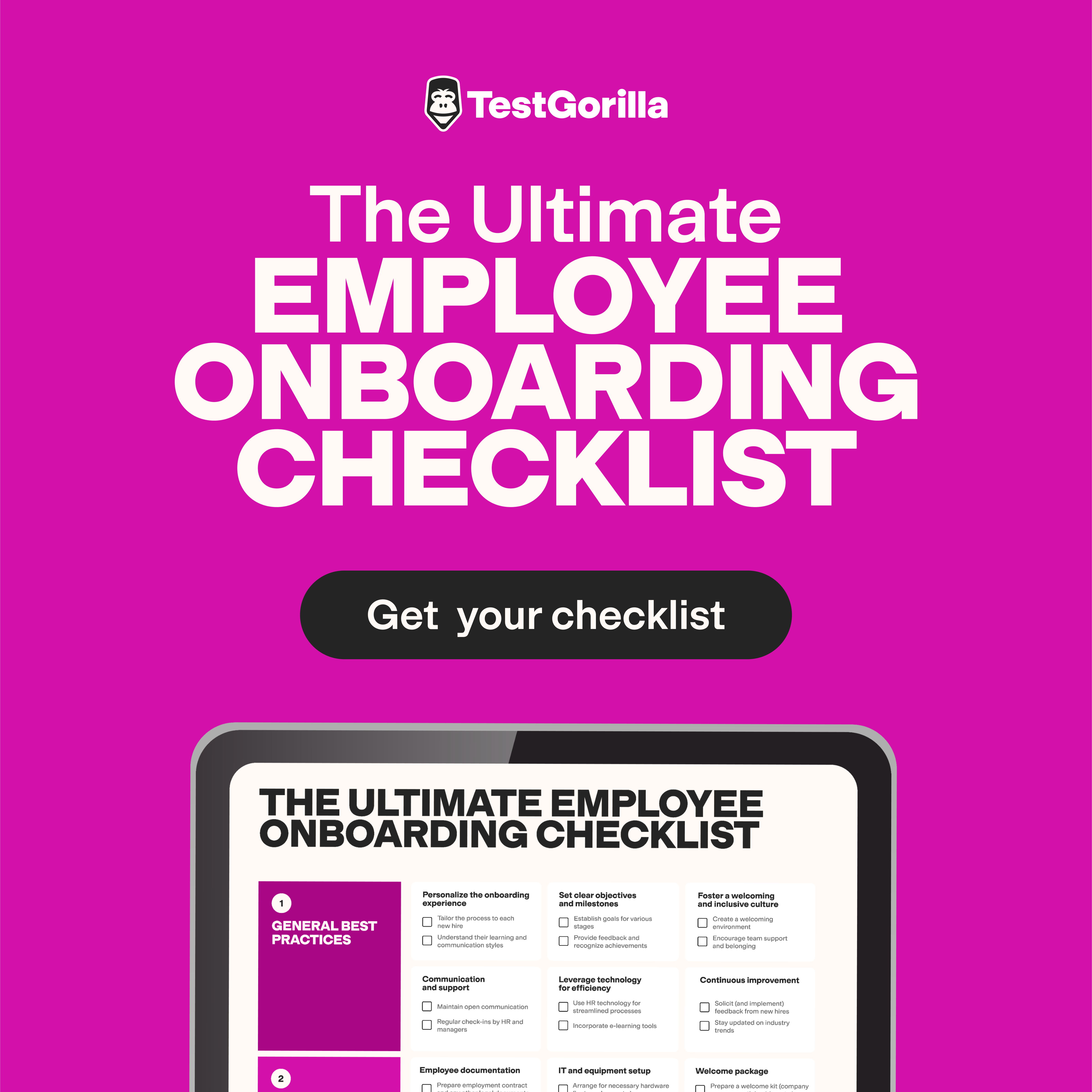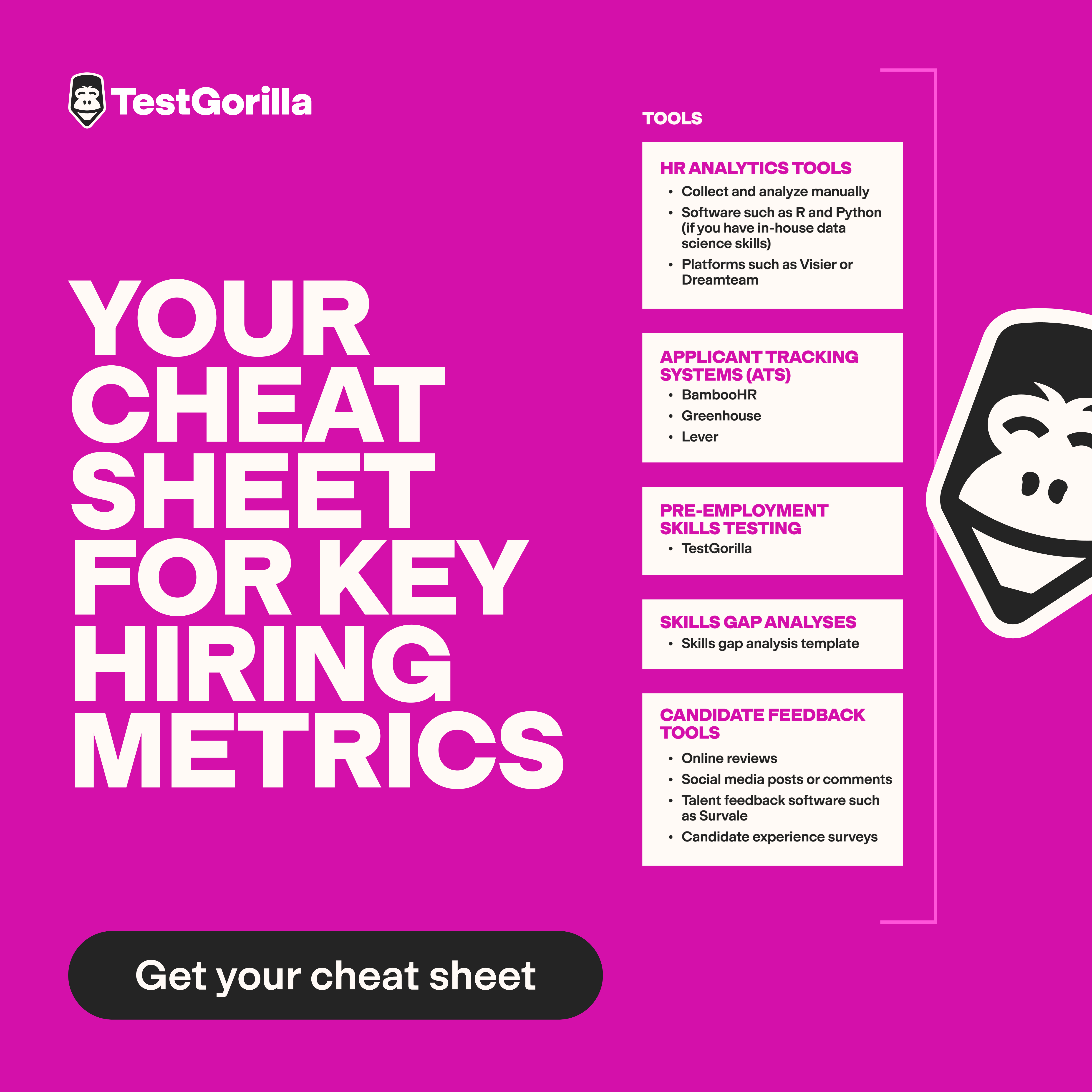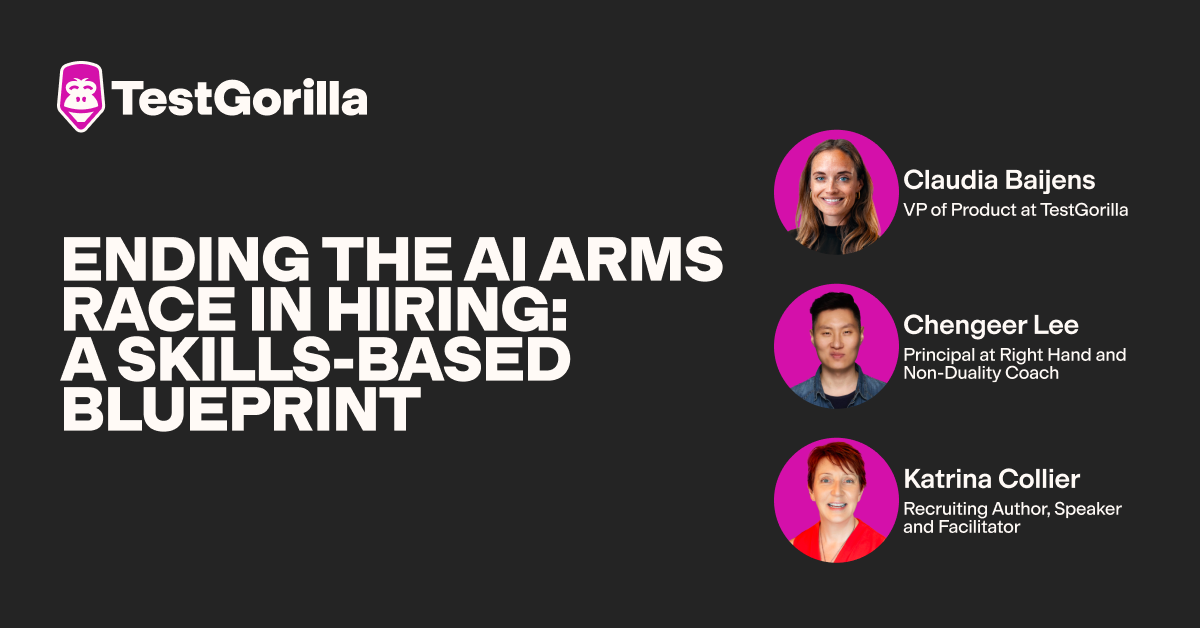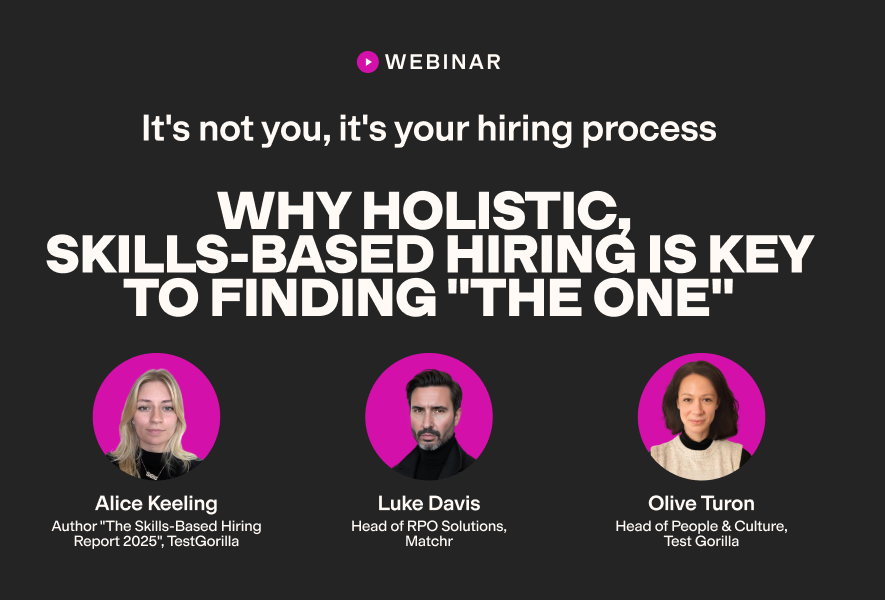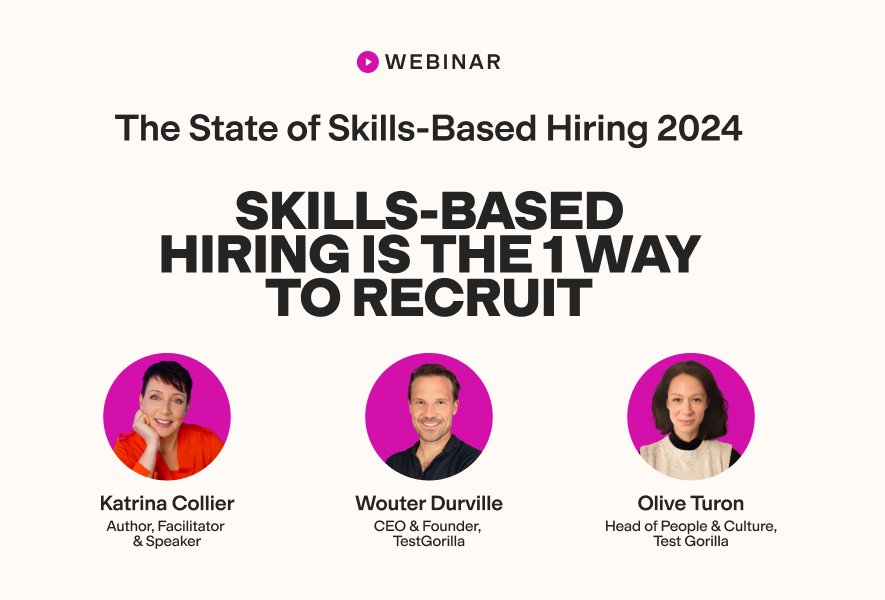In 2025, US tech companies have been laying off hundreds of employees a day on average.
These layoffs are destabilizing for not only employees and job-seekers but also hiring teams, who are being forced to rethink their approaches to recruitment. Companies of all sizes are facing surges in applications, uncertainty in evaluating fit, and pressure to move fast.
To stay both grounded and competitive, you must understand why layoffs are happening, how they affect you, and what tools you can use to adapt.
That’s why we’ve put together this guide: to go behind the headlines, unpack the evidence-based causes of layoffs, and show you how talent assessments can help you make confident hiring decisions – even in an unstable market.
Table of contents
- What’s really behind the tech layoffs
- Debunking the tech layoff narrative: The reality behind the headlines
- Will tech industry layoffs continue?
- What hiring teams should watch for now
- What all this means for hiring teams: 5 key lessons
- How to attract laid-off tech talent
- Don’t just react – rethink with skills-based hiring
- The new normal
Key news 2024 – US tech layoffs total 95,667 – roughly 1% of the total US tech workforce at the time (9.5 million). January 14, 2025 – Meta announces “low-performer” layoffs, equivalent to 5% of its global workforce. June 10, 2025 – Google offers buyouts – what CNBC describes as the company’s “latest effort to reduce headcount” – to US workers in its knowledge and information unit. This came after Google laid off 12,000 employees (6% of its workforce) in 2023. June 18, 2025 – Amazon predicts layoffs due to “AI agents.” It has laid off more than 27,000 employees since 2022. 2025 – Throughout the year, other tech giants such as Microsoft, Match, and Intel announced cuts in the thousands. |
What’s really behind the tech layoffs
When a company announces tech layoffs, the reasons sound familiar: underperformance, restructuring, or efficiency.
But those are surface-level explanations.
What’s actually fueling these cuts are macro factors (market and environment-influenced) and micro factors (firm-specific).
Macro factors
Economic contraction: The US economy saw under 2% gross domestic product (GDP) growth across four quarters between 2022 and 2025, with two of these quarters shrinking. Combined with pressure to increase share value, companies are responding by cutting anything that’s seen as having a lower return on investment (ROI) – including staff.
AI and automation: Processes that once required human input are being replaced by automation through artificial intelligence (AI) and machine learning (ML).
Less funding: After years of venture capital (VC) investment, tech companies now have lower cash injections. This has caused them to prioritize core expenses and cut anything deemed “optional.”
Micro factors
Re-prioritizing product lines: There’s pressure to compete on AI products. Massive AI R&D costs slash budgets in other areas. For Big Tech, unlike retail and manufacturing, labor is a disproportionately large expenditure item.
Overhiring: Throughout 2020 and 2021, many tech businesses expanded their workforces as demand for their services boomed. For example, Amazon, Snap, and Meta doubled their headcounts. Now, demand growth has slowed, and labor costs are squeezing margins.
Big spend items: Large investments, such as acquisitions, research and development (R&D), and new products, require spending cuts elsewhere to maintain margins and share value. For example, Amazon bought MGM for $8.5 billion in 2021 and began mass layoffs in late 2022.
Debunking the tech layoff narrative: The reality behind the headlines
Headlines will have you believe that only non-technical workers are at risk of being laid off. Or that AI is the top factor behind tech layoffs. Neither is true.
As Sahil Shah, co-founder of Say No to Disinfo, tells TestGorilla, “The media coverage, as always, accentuates some elements and underplays others.”
Let’s look at some nuances that eye-catching headlines don’t communicate.
Tech workers aren’t the only ones being laid off
It isn’t just software engineers being let go. In reality, layoffs disproportionally affect non-tech departments at tech companies, such as marketing, human resources (HR), communications, and research. (For example, Microsoft’s early 2025 announcement outlined that most of its planned layoffs would be across sales teams.)
This is the case because (a) it’s easier to automate tasks in these departments and (b) they impact revenue less directly than tech-focused departments.
AI isn’t replacing tech jobs
It's hard to predict what the economy – tech included – will look like in a few decades. Some experts believe that, at some point, AI will automate a large proportion of workplace tasks. Shah tells us that “long run lay-offs [are] almost certainly underestimated” but “short run lay-offs may well have been exaggerated.”
Unless you’re Sam Altman (OpenAI’s CEO) or one of his associates, you can't control the speed of change, so focus on the foreseeable future.
Firstly, AI isn’t replacing tech jobs – it’s changing job requirements. Second, attempting to automate jobs with AI is an experiment with no guarantee of success.
For example, Klarna shaved 40% off its headcount in 2025, replacing customer support agents with AI bots. After plummeting customer satisfaction, it is rehiring support staff and calling the AI adoption a “pilot.”
Technical skills are still in demand
According to Robert Half, most in-demand tech jobs are still software, data, and systems engineering.
It’s true that some technology teams are outsourcing code writing to AI. At Microsoft, for example, between 20 and 30% of code is “written by software.”
But because AI can’t plan or innovate, teams still need architects, engineers, and vertical-specific specialists. Techies with strong management and market analysis skills, such as product managers, will also thrive.
And even as some tech teams let go of employees, their technical skills are still in demand in other businesses or industries. For example, a big corporation might offload a user experience (UX) design team to reallocate budget for an AI project. Elsewhere, medium-sized businesses might be looking for UX talent.
The best insights on HR and recruitment, delivered to your inbox.
Biweekly updates. No spam. Unsubscribe any time.
Will tech industry layoffs continue?
Mass layoffs will continue in waves, as individual tech companies respond to macro and micro factors. For example, worsening economic conditions would increase job cuts, while approaching peak-automation in internal operations would limit them at firm-level.
Looking ahead, employers (large ones, in particular) will realize they must preserve their employer brand for employees and candidates alike. This means more companies will implement a staggered, multi-year approach to downsizing to help maintain staff morale and deter panic (and voluntary churn).
What hiring teams should watch for now
Even in the wake of layoffs, the tech workforce isn’t shrinking.
TrueUp data shows that international tech job openings rose by 10% between February 2024 and February 2025 and are on a steady rise. And in the US, the tech workforce is projected to grow at twice the rate of the national workforce in the next 10 years.
The difference? It won’t grow in the same ways we’re accustomed to. The skills and responsibilities you hire for will change.
Here are four patterns to dial into:
Hiring for two extremes
As Shah tells TestGorilla, “predicting where AI will most make progress is challenging,” but “highly quantitative/mathematical skills and skills where a human element is seen as beneficial will likely help people future-proof their career, at least in the short run.”
This means employers will increasingly hire for two extremes:
Advanced analytical skills, such as Big Data modeling, AI/ML engineering, and financial market forecasting
People-oriented skills, such as team motivation, mentoring, ethical decision-making, conflict resolution, presenting, negotiation, and rapport building
These are areas that AI will have a hard time perfecting, and which directly impact businesses' bottom lines.
On the flip side, jobs with low analytical or people skills requirements (e.g., basic administration and data entry) may gradually phase out of efficiency-driven companies.
A new definition of “entry-level”
At the biggest 15 tech companies, graduate hiring is down 50% from 2019 levels. This is partially due to AI performing manual entry-level tasks – including research, analysis, summarizing, and drafting – way faster than even the sharpest grads.
Junior hiring will eventually pick up, just with different job responsibilities. Here are some examples of entry-level skills that are outgoing – and incoming:
Out | In |
Repetitive coding and debugging | Using AI to automate basic coding tasks |
Manual desk research (for example, competitor analysis or user research) | Finding and summarizing insights using AI, plus fact-checking and interpreting outputs |
Writing SQL queries to interact with databases | Using AI copilots to draft queries while determining which metrics add the most value |
Manual lead sourcing and scoring in sales | Using AI-powered software to fetch and score leads, and spending time nurturing 1-on-1 relationships |
Leaner teams
Shah suggests that with “internal AI adoption and [...] AI development," small teams will “do what much larger teams were previously needed for.” In other words, teams are becoming leaner: doing more with less.
Speaking to TestGorilla, Toby Basalla, Founder & Principal Data Analytics Consultant at Synthelize, describes working with “companies that let two or three coordination layers sit between execution and delivery.”
“Once pressure hit, those roles collapsed under their own redundancy,” he explains. “Teams now run tighter. One client dropped from five product analysts to two, with no drop in shipping velocity."
This increased emphasis on performance and productivity will require hiring for:
Soft skills such creativity, adaptability, and problem-solving
Hard skills, including numerical reasoning and AI prompt engineering
What all this means for hiring teams: 5 key lessons
Wise hiring teams will use layoff news and insights to rebuild, not retreat. Here are five key lessons to bring into your hiring strategy:
Lesson 1: A whole new world (outside Big Tech)
Big Tech layoffs are pushing top talent to rethink where they want to work. For many, that’s in key industries needing tech skills, such as consulting, finance, and healthcare. Others are switching gear from Big Tech corporations to smaller, scrappier tech firms.
Hiring teams should capitalize on this strategic moment by:
Building job descriptions around skills, not credentials. Shift from years-of-experience, degree, and "previous experience in X” requirements to detailed role responsibilities and abilities.
Adapting your interview process to career movers. Less "tell me about a time when you…” and more real-world task simulations, scenario-based questions, and culture and motivation assessments.
Looking for transferable skills alongside the “obvious” skills for the role. For instance, you could prioritize advanced math skills and adaptability – rather than financial modeling only – in a data analyst role.
Lesson 2: Get it while it’s hot
Post-layoffs, most candidates want to move into their next role as quickly as possible. If your hiring process is slow, you could lose someone perfect for your open position.
Here’s what you can do to keep your recruitment cycles short and efficient:
Use structured interviews: Pre-define the role-specific core questions, create skill-based score cards, and ask interviewers for reasons behind ratings to avoid gut decisions.
Remove time-consuming bottlenecks: For example, let candidates select interview times using a meeting booking platform, and offer interview feedback within 24 hours.
Review real-world skills before resumes: Send out a multi-measure assessment testing key job-specific competencies. Doing this first saves time since you can easily filter out unqualified candidates and move forward with only objectively qualified ones.
Lesson 3: Don’t follow the Big Tech pack
Just because the FAANGs (Facebook, Amazon, Apple, Netflix, and Google) are freezing hiring doesn’t mean you should, too. Their reasons for letting staff go may not apply to your business, and pausing recruitment could backfire.
For small to medium-sized companies with a solid funding runway, this is a rare chance to secure top talent that would have been more cost-intensive to attract pre-layoffs.
But don’t underpay or under-perk your new hires, or they’ll leave as soon as the tech job market picks up. Instead, offer market-rate compensation and compelling benefits, such as hybrid or remote work options, career progression opportunities, paid time off, etc.
Lesson 4: Surf the applications wave responsibly
In peak layoff season, open roles often attract tons of interested candidates. That’s great news for you – until the pile of applications to review overwhelms your team, leading to rash decisions, relying on “instinct,” and hiring bias.
To counter this, we recommend you:
Avoid easy fixes like opening applications for a week or shortlisting only candidates from certain schools.
Replace resume screening with role-specific assessments at the start of your application process. These help reduce bias and HR workload.
Ensure your team interviews for key behaviors and aptitudes, not just experience.
Lesson 5: Hire for results, not tasks
AI may currently perform at the intern level, but it will soon automate more and more tasks – from prepping payroll to scheduling social media content and debugging code.
However, until it nears Artificial General Intelligence (AGI), it can't make high-stakes decisions or build human connections.
That’s why, as Basalla told us, “hiring favors people who can own a full loop of work without passing it around.”
Work alongside the automation trends by hiring candidates who can drive outcomes, adapt to changing priorities, and work with AI as a copilot. You should:
Reframe job roles around outcomes, ownership, and “backlog pain points,” as Toby suggests.
Prioritize strategic skills such as decision-making, negotiation, and leadership in interviews and skills assessments.
Pinpoint evidence of real-world impact in candidates’ previous roles (for instance, during interviews and reference checks).
How to attract laid-off tech talent
Your talent pool will likely include previously laid-off tech workers, who can bring specialized skill sets and plenty of motivation to your team.
To attract them and get that “yes” to your offer, highlight the following key aspects:
Key focus | Why? | How? |
Transparency on team stability | Establishes trust | Clarify the runway (timeline until funding runs out), funding, and team growth plans |
The role or project's value to the business | Awakens purpose and motivation | Communicate actual and potential impact on internal or external customers |
Employee-centered culture | Confirms support and respect | Offer generous benefits, internal progression and mobility, project freedom, and feedback loops |
Skills and development | Confirms commitment to learning and performance | Offer training and mentorship, including on AI and automation |
Streamlined hiring | Communicates that their time and application are valuable | Test job-ready skills early and fast-track high-potential candidates |
Don’t just react – rethink with skills-based hiring
Talented candidates are getting laid off, AI is shifting role requirements, and transferable skills are high-value currency.
All this means hiring based on assumptions and good-looking resumes doesn't land the best talent. Skills-based hiring is how you stay focused, fast, and fair.
A key part of skills-based hiring is talent assessments. These help you:
Measure abilities objectively, regardless of whether a candidate has been laid off or has career gaps
Prioritize long-run company fit over flashy FAANG experience
Identify transferable skills in career changers
Zero in on top performers with unconventional or nonlinear backgrounds
Shortlist candidates faster and more confidently
Offer candidates a clear, flexible, engaging process that they’ll appreciate
TestGorilla can help you bring skills-based hiring to life at your company. It features a library of hundreds of tests, including many tailor-made for tech hiring, that you can mix and match to create bespoke talent assessments for any of your open roles.
Here’s a taster of TestGorilla’s library:
Programming skill tests, including various frameworks (e.g., Django, Ruby on Rails) and data structures across 20 coding languages (e.g., JavaScript, R, Go)
Software skill tests, including Figma, generative AI, and AWS data analytics
Cognitive ability tests, including critical thinking and intermediate math
Situational judgment tests, including leadership and communication
Role-specific tests, including AI, UX/UI design, product management, and design thinking
The Culture Add test, which maps candidates’ values against your organization’s to check compatibility
The new normal
With waves of tech layoffs and speedy AI developments, tech recruitment is changing. Hiring teams must rethink job requirements, interview structures, and candidate interaction with skills, not credentials, in mind.
TestGorilla is a candidate-friendly talent assessment platform that helps you find stellar tech professionals for your roles. You can bundle up to five tests per assessment, from programming and role-specific hard skills to decision-making, leadership, and more.
Ready to get started? Create your first assessment with TestGorilla on a free account today.
You've scrolled this far
Why not try TestGorilla for free, and see what happens when you put skills first.


